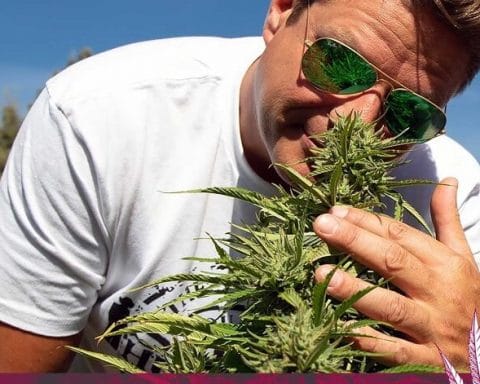Israel’s state-run Volcani Institute is at the forefront of cannabis research. One of the institute’s latest studies, published by a Master’s student from Bar-Ilan University, serves as the first study that identifies exact cannabinoid concentrations needed to kill brain cancer cells.

Hadar Peeri is a Master’s student of Environmental Biology at Bar-Ilan University and the Agriculture Research Organization, Volcani Institute in Israel.
She can’t seem to stop smiling as she looks into her webcam and tells me about her first scientific paper, which was featured earlier this month in Cancers, a peer-reviewed, open access journal of oncology published by MDPI.
“It’s a great feeling and a great honour. It’s very exciting to see where this will take us” she says, smiling through the entire sentence.
If you’d just published Hadar’s paper, you’d probably also struggle to wipe the smile from your face.
That’s because her study is truly the first of its kind.
It examines the effect of cannabis compounds on Glioblastoma multiforme (GBM) and, more specifically, demonstrates exactly what combination of cannabis compounds is most effective at treating this highly aggressive and deadly form of glioma.
“Glioma is a general term used to describe tumors that arise in glial cells. These are the non-neuronal, supportive cells in our brain, “ Hadar explains. “Glioblastomas are actually grade-4 gliomas; they are the most aggressive, most invasive, and most lethal form of brain tumor”.
Treating glioblastoma typically consists of surgery to remove the tumor where possible, combined with aggressive chemo and/or radiation therapy.
“Even then, the prognosis for glioblastoma patients has shown no improvement in the last 3 decades” explains Hadar. That prognosis consists of an estimated median survival time of 12-15 months.
Glioblastomas are so difficult to treat because they grow unlike any other tumor in the brain or body.

Instead of growing like a snowball and getting bigger and bigger over time, glioblastomas grow through the brain; some can attack both hemispheres (like the butterfly glioma pictured above) while others can even be multifocal, meaning they’re able to grow at many different sites in the brain simultaneously.
Glioblastomas are also particularly hard to remove with surgery because they spread rapidly through the brain via white matter pathways and can take on complex, 3-dimensional shapes that can compromise key centers of the brain that govern our ability to move, speak, and think.
There is also evidence that suggests GBM tumors contain subpopulations of cancer cells called GBM stem cells, which play a key role in the tumor’s recurrence, progression, and treatment resistance.
“Treatment might give patients a bit more time, but new therapies or approaches to this disease are really needed,” says Hadar.
Her study, luckily, may just serve as the basis for finding these new and improved approaches to treating GBM.
“As far as we can say, based on our results, cannabis has 2 very important functions on glioblastoma cells. The first is to kill the cells, and the second is to abolish their ability to warp and form the secondary structures that characterize the spread of this disease,” explains Prof. Hinanit Koltai, Hadar’s supervisor and the Head of Koltai Lab at the Volcani Institute.

Hinanit has worked as a scientist at the Volcani Center for 2 decades, but she only shifted her focus to cannabis roughly 6 years ago.
“I worked for years on different subjects such as plant physiology and plant hormones, but still I felt like I wasn’t fulfilling my abilities. Even though I was a professor-grade scientist and probably could have just relaxed, I felt like something was missing,” Hinanit laughs.
That’s when she decided to completely shift her research focus to study medicinal plants.
“I started abandoning my other fields of research. My aim was that through my research in this new field, we would help develop medical products derived from plants. And that is the journey we are still on today.” tells me Hinanit.
Hinanit explains that Hadar’s research is a huge step forward in helping us derive functional medicines from cannabis because it helps identify specific compositions of the plant’s compounds that work in the treatment of this particular disease.
One of the biggest limitations of the research that’s been conducted on cannabis so far, says Hinanit, is that it is very focused on the specific actions of single compounds.
“When you take CBD oil, there’s CBD in it, for sure. But the oil also contains many other compounds, and their composition is so important so that if you don’t understand exactly the composition of what you’re taking or the composition you need to be taking, you cannot know what works for you,”

She believes that this gap in our understanding of cannabis is one of the main reasons underlying the lack of clinical trials on cannabis compounds as anti-cancer drugs.
Hadar’s study, however, is the first piece of research starting to address this gap in our understanding of cannabis as a medicine.
Her research looked at extractions from 5 different strains of cannabis and found two extract fractions from a strain called Dairy Queen (one rich in THC and another with no THC but loaded with CBG) to be significantly effective in killing GBM cells and inhibiting their ability to spread.
Despite the fact that humans have been using cannabis for over 6,000 years, understanding and optimising our use of this seemingly familiar plant is no simple task.
In fact, it’s what Hinanit and her team of researchers have been working towards for the past 6 years.
The fact that cannabis contains hundreds of different compounds, including roughly 150 phytocannabinoids, hundreds of terpenes, and hundreds of flavonoids, poses a huge challenge in our ability to create medicines that need to treat specific ailments in very precise ways.
Each cannabis plant is also capable of producing varying concentrations of all of these different compounds. In fact, the specific concentration of cannabis compounds can vary among the flowers taken from plants considered to be the same strain as well as individual flowers taken from the same plant.
Understanding these challenges lay even more weight to Hadar’s findings, especially once we consider that the last stretch of her study was conducted under strict regulations imposed by the global COVID-19 crisis.
However, Hinanit is quick to mention that there are, as always, limitations to the results of this study, the biggest being that it hasn’t been tested in a clinical setting on patients.
“In many preclinical trials and animal studies it’s been quite clear that cannabis has anti-cancer properties. However, and this needs to be made very clear, to-date there are still no clinical trials that show that cannabis has anti-cancer effects” Hinanit explains.
Hadar’s research, however, has started to lay down the foundations to test specific concentrations of cannabis compounds in clinical trials on patients with Glioblastoma.
“Right now, I am just focused on my thesis, which is a lot of work and a lot of writing,” Hadar laughs, when I ask her about her plans for the future.
Once she finishes her thesis, she says she hopes to go on to a PhD and continue expanding her knowledge on cannabis.
“I am just really happy I had the opportunity to research such an interesting and important field. It’s a great honour, and I’d like to express my sincere gratitude to all my lab mates and to my supervisor Hinanit for all their support along the way. I am really thankful,” she finishes, still smiling.












